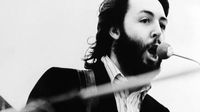The Beatles' song "Let It Be" is one of the band's most iconic tracks, but its origins are steeped in emotional complexity and multiple interpretations. The song, which served as the title for both the final Beatles album and the accompanying film, was inspired by a dream Paul McCartney had about his late mother, Mary, who passed away from cancer when he was just 14 years old. In a 2018 appearance on James Corden's "Carpool Karaoke," McCartney shared that in this dream, his mother reassured him, saying, "It's gonna be OK. Just let it be..." This heartfelt revelation has often been cited as the primary inspiration behind the song, particularly the lyric referencing "Mother Mary."
However, another narrative has emerged, adding layers to the song's backstory. Mal Evans, who was a close associate of The Beatles and served as their roadie and personal assistant, claimed in a 1975 television special titled "A Salute To The Beatles" that he was the true inspiration for the song. According to Evans, during a meditation session, he appeared to McCartney in a vision, saying, "let it be, let it be." This version of events has sparked debate among fans and historians alike, as it contrasts with McCartney's more widely accepted account.
Evans recounted a late-night conversation with McCartney, where he described the moment: "It was 3 o’clock in the morning, raining, dark in London, and Paul was telling this, saying I've written this song. It was gonna be Brother Malcolm but I’ve had to change it in case people get the wrong idea!” This anecdote adds a layer of camaraderie and creativity to the songwriting process, showcasing how inspiration can come from unexpected places.
Adding to the intrigue, an outtake that surfaced during the 2018 50th anniversary reissue of The Beatles' "White Album" revealed McCartney experimenting with the lyrics of "Let It Be" while recording another song, "Piggies," in September 1968. The lyrics included a line that referenced "Brother Malcolm," suggesting that Evans' influence was indeed significant during the song's creation. This discovery has led many to ponder the validity of both McCartney's and Evans' accounts.
Mal Evans' life came to a tragic end in January 1976 after a confrontation with police in Los Angeles, leaving many questions about his contributions to The Beatles' legacy unanswered. His claim to have inspired one of their most famous songs adds a bittersweet note to his story.
The Beatles, who began their meteoric rise in 1963, captivated audiences not only in the UK but also across Europe. Their breakthrough in the United States came in February 1964 with the hit "I Want To Hold Your Hand," which captured the attention of over 73 million viewers during their appearance on "The Ed Sullivan Show." This marked the beginning of a cultural phenomenon known as Beatlemania, which saw the band transition from local Liverpool legends to global superstars almost overnight.
Just a month after their American debut, The Beatles began filming their first movie, "A Hard Day's Night," directed by Richard Lester. The film, which showcased the band in a comedic light, followed them through two chaotic days leading up to a television appearance. The soundtrack of the movie also marked their third studio album, featuring entirely original compositions by the band.
The title "A Hard Day's Night" emerged serendipitously from a comment made by Ringo Starr during a concert. Ringo explained, "I came up still thinking it was day I suppose, and I said, 'It's been a hard day...' and I looked around and saw it was dark so I said, '...night!'" This spontaneous remark turned into one of the band's most beloved songs, showcasing how casual banter can lead to iconic music.
In a competitive spirit documented by John Lennon in a 1980 interview, he noted the rivalry between him and McCartney regarding who would produce the hit singles. Lennon said, "If you notice, in the early days the majority of singles, in the movies and everything, were mine ... in the early period I'm dominating the group ... The reason Paul sang on 'A Hard Day's Night' (in the bridge) is because I couldn't reach the notes." This friendly competition fueled their creativity and led to the production of timeless tracks.
Initially, McCartney was hesitant about using the phrase "A Hard Day's Night" as a song title, but the idea grew on him. Reflecting on their songwriting process, he recalled, "Usually, John and I would sit down and if we thought of something we'd write a song about it. But Walter Shenson asked John and me if we'd write a song specially for the opening and closing credits." Eventually, they embraced the title, turning it into a narrative about the struggles of their day-to-day lives and the joy of returning home.
The song was recorded at EMI Studios on April 16, 1964, in under three hours, much to the astonishment of producer Walter Shenson, who remarked on the band's efficiency and talent. The single, along with its namesake album, achieved a historic milestone in August 1964 by becoming the first album to top the charts simultaneously in both America and the United Kingdom.
Even years later, McCartney continues to cherish "A Hard Day's Night," often featuring it as the opener for his latest 'Got Back' tour shows. The track remains a testament to The Beatles' unparalleled creativity and impact on music and culture, a legacy that continues to resonate with fans around the world.





